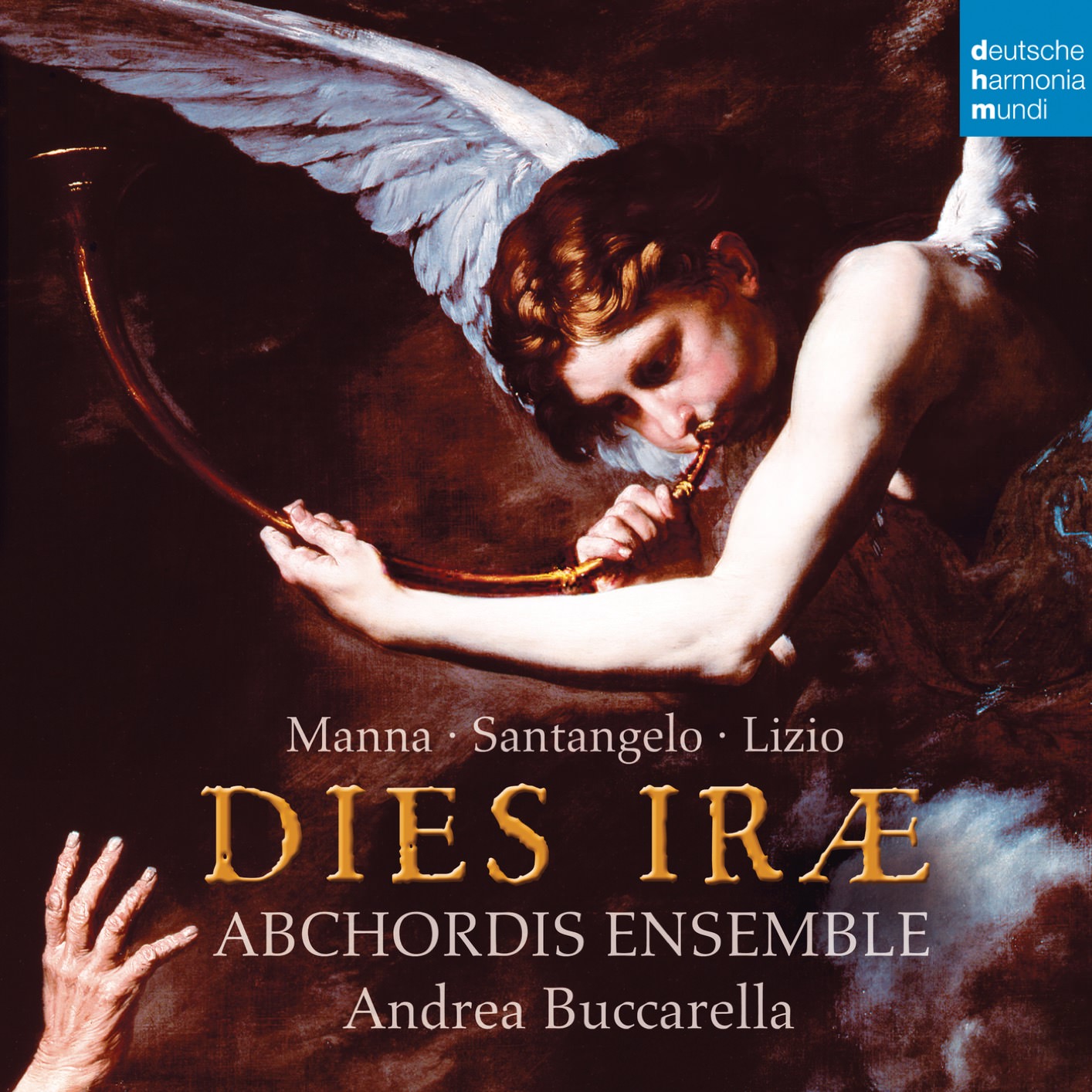
Abchordis Ensemble – Dies Irae – Sacred & Instrumental Music from 18th Century Naples (2018)
FLAC (tracks) 24 bit/96 kHz | Time – 51:53 minutes | 975 MB | Genre: Classical
Studio Masters, Official Digital Download | Booklet, Front Cover | © deutsche harmonia mundi
The composers presented in this recording, Aniello Santangelo, Gennaro Manna and Ferdinando Lizio, were trained and worked all their lives in Naples, both as teachers in the fantastic “musical forges” represented by the town’s four conservatories; and as instrumentalists in the five theatres (no less) that Naples boasted. Between 1732 and 1737, for example, Santangelo was a violinist for the Teatro de Fiorentini, the Teatro Nuovo and the Teatro San Carlo. Then, from 1759 to 1771, he was a teacher of violin, viola, cello and double bass at the Pietà dei Turchini Conservatory, along with his colleague Ferdinando Lizio, who taught oboe, transverse flute, recorder and bassoon. It is likely that Santangelo wrote several compositions for pedagogical purposes, including this never-before-recorded Trio two violins and basso continuo, composed along the lines of the classic “Sonata da Chiesa” (Church Sonata): slow, rapid fugue, and then two dances, one slow and the other lively. This sonata offers moments of great lyricism and emotion, realised with simple musical measures, from the most dramatic to the most frivolous, and typically Neapolitan. The album then continues with two pieces with bassoon obbligato : the religious motet O mundi infelix vita!, for solo bass and bassoon by Manna, superbly demanding for both soloists; and a concerto by Lizio. It seems that in the 1760s, this concerto was another obbligato piece for pedagogical use, or indeed used for the final exam for Lizio’s own bassoon students at the Pietá Conservatory. The album by Ensemble Abchordis opens with the expansive Dies Irae by Manna, written around the mid- 18th century, but which contains some very, very strong echoes of an earlier work by Francesco Feo – which suggests that Manna’s real contribution would in fact be rather smaller, just enough so that the work wouldn’t count as a copy of the earlier piece, with the addition of some horns (true, a very original step, in the Tuba mirum, the Oro supplex and the Rex tremendae), and the amendment of several vocal parts. But as this is the authentic Manna manuscript which is being played, the performers have named him as the father, also mentioning Feo’s piece.
Tracklist:
01. Dies Irae-Sequenza de’ morti: I. Dies irae
02. Dies Irae-Sequenza de’ morti: II. Tuba mirum
03. Dies Irae-Sequenza de’ morti: III. Liber scriptus
04. Dies Irae-Sequenza de’ morti: IV. Judex ergo
05. Dies Irae-Sequenza de’ morti: V. Rex tremendae
06. Dies Irae-Sequenza de’ morti: VI. Juste Judex
07. Dies Irae-Sequenza de’ morti: VII. Ingemisco
08. Dies Irae-Sequenza De’ Morti: VIII. Inter Oves
09. Dies Irae-Sequenza de’ morti: IX. Oro supplex
10. Dies Irae-Sequenza de’ morti: X. Lacrymosa
11. Trio, Op. 1, No. 6: I. Larghetto
12. Trio, Op. 1, No. 6: II. Allegro
13. Trio, Op. 1, No. 6: III. Larghetto
14. Trio, Op. 1, No. 6: IV. Allegro
15. O mundi infelix vita!: I. O mundi infelix vita! (Recitativo)
16. O mundi infelix vita!: II. Clamat ad astra (Aria)
17. Concerto di Fagotto Solo con Violini e Basso: I. Allegro
18. Concerto di Fagotto Solo con Violini e Basso: II. Largo
19. Concerto di Fagotto Solo con Violini e Basso: III. Allegro
Download:
mqs.link_AbchrdisEnsembleDiesIraeSacredInstrumentalMusicfrm18thCenturyNaples20182496.part1.rar
mqs.link_AbchrdisEnsembleDiesIraeSacredInstrumentalMusicfrm18thCenturyNaples20182496.part2.rar




















![Marie Lys, Abchordis Ensemble, Andrea Buccarella - Amate Stelle: Arias for Anna Maria Strada (2023) [FLAC 24bit/96kHz] Marie Lys, Abchordis Ensemble, Andrea Buccarella - Amate Stelle: Arias for Anna Maria Strada (2023) [FLAC 24bit/96kHz]](https://imghd.xyz/images/2023/02/17/pmgoj9pa0uhob_600.jpg)
![Abchordis Ensemble - Giacomo Sellitto: Stabat Mater (2016) [Qobuz FLAC 24bit/96kHz] Abchordis Ensemble - Giacomo Sellitto: Stabat Mater (2016) [Qobuz FLAC 24bit/96kHz]](https://getimg.link/images/imgimgimg/uploads/2017/12/beWqC7w.jpg)
![Il Tesoro di San Gennaro: Sacred music in early 18th-century Naples - I Turchini, Antonio Florio (2013) [Qobuz FLAC 24bit/44,1kHz] Il Tesoro di San Gennaro: Sacred music in early 18th-century Naples - I Turchini, Antonio Florio (2013) [Qobuz FLAC 24bit/44,1kHz]](https://getimg.link/images/imgimgimg/uploads/2018/02/mlwbQwv.jpg)
![Silvia Frigato - Feo & Manna: Lux in tenebris (Liturgy and Devotion in 18th Century Naples) (2017) [Qobuz FLAC 24bit/44,1kHz] Silvia Frigato - Feo & Manna: Lux in tenebris (Liturgy and Devotion in 18th Century Naples) (2017) [Qobuz FLAC 24bit/44,1kHz]](https://getimg.link/images/imgimgimg/uploads/2018/07/JVdyYHl.jpg)
![London Symphony Orchestra, Gianandrea Noseda - Verdi: Requiem (1874) (2016) [FLAC 24bit/96kHz] London Symphony Orchestra, Gianandrea Noseda - Verdi: Requiem (1874) (2016) [FLAC 24bit/96kHz]](https://getimg.link/images/imgimgimg/uploads/2019/01/6VMV0BH.jpg)
![Bach Choir, London Symphony Chorus, London Symphony Orchestra & Benjamin Britten - Britten: War Requiem (1963/2013) [FLAC 24bit/96kHz] Bach Choir, London Symphony Chorus, London Symphony Orchestra & Benjamin Britten - Britten: War Requiem (1963/2013) [FLAC 24bit/96kHz]](https://getimg.link/images/imgimgimg/uploads/2019/11/ICdCUfg.jpg)
![Lorin Maazel - Britten: War Requiem (2017) [Qobuz FLAC 24bit/44,1kHz] Lorin Maazel - Britten: War Requiem (2017) [Qobuz FLAC 24bit/44,1kHz]](https://getimg.link/images/imgimgimg/uploads/2017/11/blmrap4.jpg)
![Riccardo Muti, Chicago Symphony Orchestra & Chorus - Verdi: Messa da Requiem (2011) [HDTracks FLAC 24bit/88,2kHz] Riccardo Muti, Chicago Symphony Orchestra & Chorus - Verdi: Messa da Requiem (2011) [HDTracks FLAC 24bit/88,2kHz]](https://getimg.link/images/imgimgimg/uploads/2017/12/RVtgq5c.jpg)
![Zuzana Ruzickova - J.S. Bach: The Complete Keyboard Works (2016) [FLAC 24bit/96kHz] Zuzana Ruzickova - J.S. Bach: The Complete Keyboard Works (2016) [FLAC 24bit/96kHz]](https://getimg.link/images/imgimgimg/uploads/2018/09/r94XYtX.jpg)
![Max Emanuel Cencic - Handel: Ottone, HWV 15 (2017) [Qobuz FLAC 24bit/96kHz] Max Emanuel Cencic - Handel: Ottone, HWV 15 (2017) [Qobuz FLAC 24bit/96kHz]](https://getimg.link/images/imgimgimg/uploads/2017/11/9uXCAkQ.jpg)
![Ensemble Correspondances & Seebastien Dauce - Charpentier: Histoires sacrees (2019) [FLAC 24bit/88,2kHz] Ensemble Correspondances & Seebastien Dauce - Charpentier: Histoires sacrees (2019) [FLAC 24bit/88,2kHz]](https://getimg.link/images/imgimgimg/uploads/2019/12/SAy0dQV.jpg)
![Pacifica Quartet - Dmitri Shostakovich and his Contemporaries: The Soviet Experience Vol. 1-4 (2011-2013) [24bit FLAC] Pacifica Quartet - Dmitri Shostakovich and his Contemporaries: The Soviet Experience Vol. 1-4 (2011-2013) [24bit FLAC]](https://getimg.link/images/imgimgimg/uploads/2017/07/ntIbtOp.jpg)
![Aniello Desiderio - Nocturnal (2017) [FLAC 24bit/96kHz] Aniello Desiderio - Nocturnal (2017) [FLAC 24bit/96kHz]](https://getimg.link/images/imgimgimg/uploads/2017/10/Qr2KVgK.jpg)
![Andrea Buccarella, Abchordis Ensemble - Antonio Vivaldi: Serenata a tre (2023) [FLAC 24bit/96kHz] Andrea Buccarella, Abchordis Ensemble - Antonio Vivaldi: Serenata a tre (2023) [FLAC 24bit/96kHz]](https://imghd.xyz/images/2023/04/19/sq85k8l9wzt8a_600.jpg)
![Ensemble Barocco di Napoli & Abchordis Ensemble - Il soffio di Partenope (2019) [FLAC 24bit/96kHz] Ensemble Barocco di Napoli & Abchordis Ensemble - Il soffio di Partenope (2019) [FLAC 24bit/96kHz]](https://getimg.link/images/imgimgimg/uploads/2020/04/QFuNsTa.jpg)